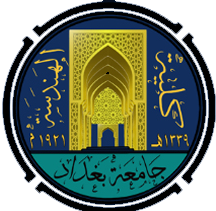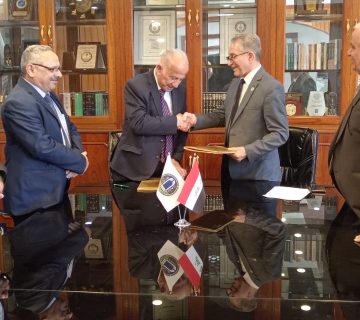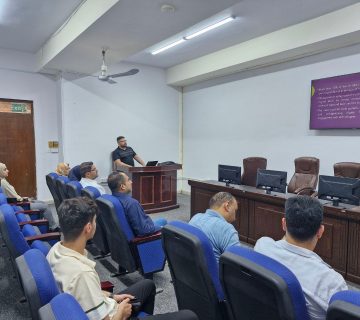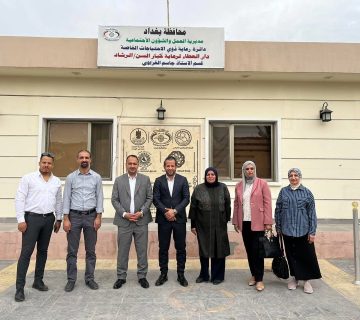نوقشت رسالة الماجستير الموسومة:
” Developing a Real Time Application of Cloud Services for Mobile Robots”
التي اعدتها طالبة الماجستير في قسم الهندسة الكهربائية – كلية الهندسة / جامعة بغداد كجزء من متطلبات نيل درجة الماجستير في علوم الهندسة الكهربائية سارة حيدر عبد الرضا وبإشراف أ.م.د. ضياء جاسم كاظم يوم الاثنين المصادف 29/6/2020.تكونت لجنة المناقشة لهذه الرسالة من أ.د. محمد زكي الفائز رئيسا وعضوية أ.م.د. منى هادي صالح وأ. م.د. أبراهيم قاسم ابراهيم.
خلاصة رسالة الطالبة كما يلي:
يتناول هذا البحث أمكانية أستكشاف الروبوت المتنقل لموقعه في البيئات الغير معروفة ومن ثم إنشاء خرائط لهذه البيئات للاستخدام المستقبلي. في هذا العمل ، أقترحنا استخدام خوارزمية معدلة تسمى التوطين المتزامن ورسم الخرائط (SLAM) ، بعد ذلك أقترحنا أستخدام النسخة المطورة من هذه الخوارزمية المسمأة Extended Kalman Filter (EKF) لحل مشكلة SLAM حيث يتم تنفيذ EKF-SLAM لبيئات غير معروفة مختلفة تحتوي على عدد مختلف من المعالم (Landmarks). ستلعب المعالم القابلة للكشف دورًا مهمًا في التحكم في عملية التنقل الشاملة وأداء تقنية EKF-SLAM ، ثم تم أقتراح ثلاث خوارزميات ذكية أخرى لتحسين أداء مسار EKF-SLAM للروبوت المتحرك ، الأولى عن طريق أقتراح خوارزمية تحسين سرب الجسيمات (PSO) ، والخوارزمية الثانية المسمأة تحسين سرب الجسيمات الفوضوية (CPSO) والخوارزمية الثالثة هي الخوارزمية الجينية (GA) ، بعد ذلك قمنا بمحاكاة وتقييم منصة روبوت متنقلة تسمى TurtleBot2e في برنامج المحاكاة Gazebo لتحقيق تقنية SLAM لبيئات مختلفة تعتمد على منصة Rviz التي بنيت على نظام تشغيل الروبوت (ROS) في نظام التشغيل Linux.
أظهرت نتائج المحاكاة بأستخدام برنامج الماتلاب أن تقنية EKF-SLAM لديها أداء أفضل من طريقة أستخدام قياس المسافات (Odometry Approach) ومعيارنا كان هو قياس متوسط الخطأ التربيعي (MSE) أخذين بنظر الاعتبارزيادة عدد المعالم. ومن جهة أخرى أظهرت نتائج الماتلاب أيضاً أن تقنية CPSO تتفوق على التقنيات الاخرى (PSO،(GA من حيث تقليل متوسط الخطأ التربيعي لـ EKF-SLAM وفقًا للمسار الفعلي مع زيادة عدد المعالم التي تعطي أيضًا أداء أعلى من طريقة أستخدام قياس المسافات (Odometry Approach).
أخيراً، أقترحنا في هذا العمل أستخدام خادم TONIDO السحابي لتوفير حلول الخدمات السحابية لأنه يدعم الميزات المطلوبة للأغراض التعليمية والأكاديمية. بعد ذلك تم اقتراح وتنفيذ طرق الوصول المقترحة المرنة وغيرالمكلفة فيما يتعلق بالتطبيقات في الوقت الحقيقي التي تمكن المستخدمين من الوصول إلى الخدمات السحابية محليًا وإقليميًا. عملياً لمحاكاة اتصال شبكتنا ، اقترحنا استخدام Raspberry-pi3 model B + لبناء شبكتنا لتمكين المستخدمين من الوصول إلى الخدمات السحابية عبر الاتصالات اللاسلكية والسلكية. وكمثال عملي لدراسة حالة تطبيق في الوقت الحقيقي عبر الخادم السحابي ، اقترحنا إجراء بث مباشر للفيديو باستخدام كاميرا ويب IP وسحابة IVIDEON حيث يمكن الوصول إلى الفيديو المتدفق عبر الخادم السحابي في أي وقت مع مستخدمين مختلفين مع مراعاة اتصالات العملية المقترحة.
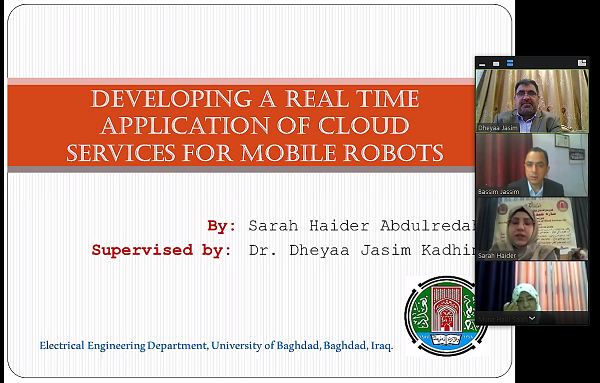
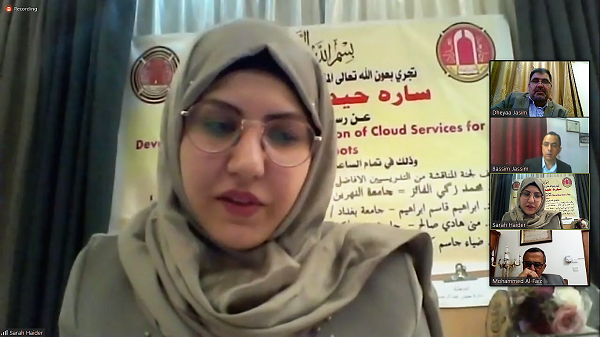
M.Sc. Student in Electrical Engineering Department
“Sara Haidar AbdulRedha” Defends Her Thesis
Translated by: Dr. Rabab Hameed Shghedl Al-Darraji
The M.Sc. student Ms. Sara Haidar AbdulRedha was examined in the contents of the thesis entitled:
“Developing a Real Time Application of Cloud Services for Mobile Robots”
which she prepared in the Department of Electrical Engineering/College of Engineering/Baghdad University in partial fulfillment of the requirements for the degree of Master of Science in Electrical Engineering under the supervision of Asst. Prof. Dheya Jassem Kazem, Ph.D. on Monday 29th June, 2020.The examining committee consisted of Prof. Mohammad Zaki AlFaez, Ph.D.(Chairperson of the Examining Committee) and Asst. Prof. Muna Hadi Saleh , Ph.D. and Asst. Prof. Ibraheem Kassim Ibraheem, Ph.D. (Members of the Examining Committee).
The abstract of the thesis is as follows:
This research deals with the feasibility of a mobile robot to navigate and discover its location in unknown environments and then to construct maps of these navigated environments for future usage. In this work, we proposed to use a modified algorithm named Simultaneous Localization and Mapping (SLAM). Then, the Extended Kalman Filter algorithm (EKF) is suggested to solve the SLAM problem where EKF-SLAM is implemented for different unknown environments containing a different number of landmarks. Then, three intelligent optimization algorithms are proposed to enhance the performance of the EKF-SLAM trajectory of the mobile robot. These algorithms are particle swarm optimization (PSO), chaotic particle swarm optimization (CPSO) algorithm and genetic algorithm (GA). After that, we simulated and evaluated a mobile robot platform named TurtleBot2e in the Gazebo simulator to achieve the SLAM technique for a different environment based on the Rviz library built on Robot Operating System (ROS) booted in Linux.
MATLAB simulation results show that the EKF-SLAM technique has better performance than the Odometry approach in terms of measuring the mean square error, especially when increasing the number of landmarks. Also, the simulation results show that CPSO technique outperforms the PSO and GA techniques. So, CPSO optimization is more optimal and gives the best performance which equals 95.74 while the performance of PSO equals 90.12 with the environment which contains eight landmarks case. Simulation results also show that with CPSO technique, the MSE1 is decreased from 0.2154 to 0.0426 and the performance (Perf.1) is increased from 78.4601 to 95.74 concluding that the CPSO gives good results with few iterations as compared with PSO-EKF-SLAM and traditional EKF-SLAM.
This work proposed using TONIDO cloud server to provide cloud services solutions since it supports the features required for educational and academic purposes. Practically, to simulate our network connection, we proposed to use the Raspberry-pi3 model B+ as a router wireless LAN that enables users to access cloud services via wireless and wireline connections. As a case study for a real-time application over the cloud server, we suggested doing a live video streaming using an IP webcam and IVIDEON cloud where the streaming video can be accessed via the cloud server at any time with different users taking into account our proposed practical connections.

